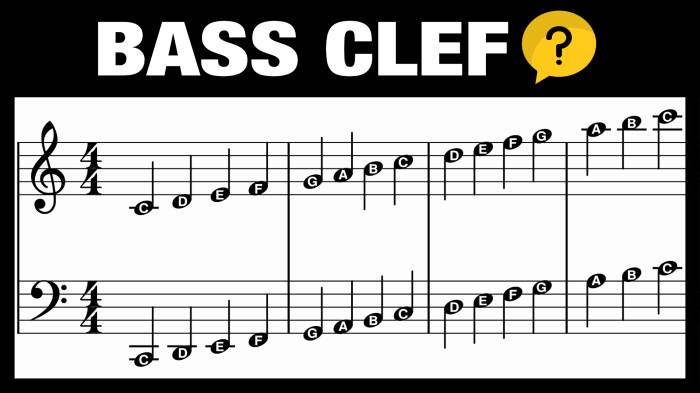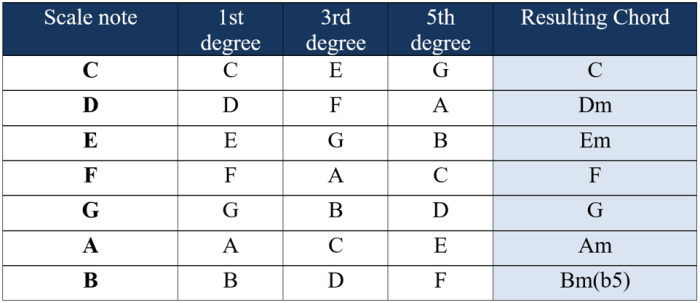C major triad bass clef – The C major triad is one of the most fundamental chords in music, and it’s essential for bassists to understand how to play it in the bass clef. In this guide, we’ll explain the notes that make up the C major triad, show you how to play it, and discuss its harmonic function.
The C major triad is made up of the notes C, E, and G. In the bass clef, the C is played on the second line, the E is played on the fourth line, and the G is played on the top line.
C Major Triad in Bass Clef

The C major triad in the bass clef consists of the notes C, E, and G. These notes are arranged in ascending order, with C being the lowest note and G being the highest note. The C major triad is a fundamental chord in Western music and is used in a wide variety of musical styles.
Notes in the C Major Triad
The notes in the C major triad are:
- C (lowest note)
- E (middle note)
- G (highest note)
Fingerings for the C Major Triad
The fingerings for the C major triad in the bass clef are:
- C: 1st finger
- E: 3rd finger
- G: 4th finger
Intervals in the C Major Triad: C Major Triad Bass Clef

The C major triad consists of three notes: C (the root), E (the third), and G (the fifth). The intervals between these notes are as follows:
- Root to third: A major third (4 half steps)
- Root to fifth: A perfect fifth (7 half steps)
- Third to fifth: A minor third (3 half steps)
These intervals contribute to the sound of the C major triad in several ways. The major third interval gives the triad its bright and cheerful sound. The perfect fifth interval adds stability and fullness to the sound. The minor third interval adds a hint of tension and complexity.
Voicings of the C Major Triad
The C major triad can be voiced in several different ways. The most common voicing is the root position, in which the root note is the lowest note. Other voicings include the first inversion, in which the third note is the lowest note, and the second inversion, in which the fifth note is the lowest note.
The different voicings of the C major triad can be used to create different effects. The root position voicing is the most stable and has the strongest foundation. The first inversion voicing is less stable and has a more open sound.
The second inversion voicing is the least stable and has the weakest foundation.
Inversions of the C Major Triad

Inversions of a chord are different arrangements of its notes. The C major triad has three inversions, each with a different bass note.
Root Position, C major triad bass clef
The root position is the most common inversion of the C major triad. The bass note is C, the root of the chord. The other two notes are E and G, arranged in thirds above the bass note.
First Inversion
The first inversion of the C major triad has E as the bass note. The other two notes are C and G, arranged in thirds above the bass note. This inversion is also known as the “6/4 chord” because the bass note is a sixth above the root of the chord.
Second Inversion
The second inversion of the C major triad has G as the bass note. The other two notes are C and E, arranged in thirds above the bass note. This inversion is also known as the “4/6 chord” because the bass note is a fourth above the root of the chord.
Uses of Inversions
Inversions are used in music for a variety of purposes. They can be used to create different sounds and textures, to avoid monotony, and to create harmonic movement. Root position is the most stable inversion, while the other inversions are more dissonant.
First inversion is often used to add tension to a chord, while second inversion is often used to create a sense of movement.
The C major triad in bass clef is a fundamental building block of music theory. Its simplicity and familiarity make it an excellent starting point for understanding chords and their functions. However, if you’re looking for something a bit more obscure, consider exploring si joint x ray oblique . This specialized medical imaging technique offers a unique perspective on the sacroiliac joint, providing valuable insights for diagnosing and treating related conditions.
Returning to our musical roots, the C major triad remains a cornerstone of countless compositions, its enduring appeal a testament to its timeless beauty.
Harmonic Function of the C Major Triad

The C major triad, consisting of the notes C, E, and G, plays a significant role in Western music as a foundational harmonic element. Its harmonic function varies depending on the musical context, creating distinct moods and emotions.
As a Tonic Triad
In the key of C major, the C major triad functions as the tonic triad. It provides a sense of stability and resolution, often appearing at the end of musical phrases or sections. The tonic triad establishes the key center and serves as a reference point for other chords and melodies.
As a Subdominant Triad
In the key of F major, the C major triad acts as the subdominant triad. It creates a sense of anticipation or movement, often leading to the dominant triad (G major). The subdominant triad adds variety and interest to harmonic progressions, providing a contrast to the tonic and dominant triads.
As a Dominant Triad
In the key of G major, the C major triad functions as the dominant triad. It generates a sense of tension and resolution, often leading to the tonic triad. The dominant triad is essential for creating harmonic drive and forward motion in music.
Emotional Impact
The C major triad is associated with a range of emotions, including joy, happiness, and optimism. Its bright and cheerful sound makes it a popular choice for uplifting and celebratory music. In classical music, the C major triad is often used in triumphant or heroic themes.
In popular music, it is commonly employed in pop, rock, and country genres to create a positive and energetic atmosphere.
FAQ Overview
What are the notes in the C major triad?
The notes in the C major triad are C, E, and G.
How do I play the C major triad in the bass clef?
To play the C major triad in the bass clef, play the C on the second line, the E on the fourth line, and the G on the top line.
What is the harmonic function of the C major triad?
The C major triad is a major triad, which means it has a bright and cheerful sound. It can be used to create a sense of stability and resolution in music.
